What is the research evidence on writing? - Department for Education
What is the research evidence on writing? - Department for Education
What is the research evidence on writing? - Department for Education
Create successful ePaper yourself
Turn your PDF publications into a flip-book with our unique Google optimized e-Paper software.
that use of some ‘technology-influenced’ features appeared <strong>on</strong> <str<strong>on</strong>g>the</str<strong>on</strong>g>ir <strong>writing</strong> <strong>for</strong><br />
school. For example, 50 per cent of teenagers said that <str<strong>on</strong>g>the</str<strong>on</strong>g>y sometimes use in<strong>for</strong>mal<br />
<strong>writing</strong> styles instead of proper capitalizati<strong>on</strong> and punctuati<strong>on</strong> in <str<strong>on</strong>g>the</str<strong>on</strong>g>ir school<br />
assignments, and 38 per cent have used text shortcuts such as ‘lol’ (‘laugh out loud’)<br />
(Pew Internet, 2008).<br />
6.2 Enjoyment of <strong>writing</strong><br />
Findings from <str<strong>on</strong>g>the</str<strong>on</strong>g> Nati<strong>on</strong>al Literacy Trust (NLT) studies suggest that overall a large<br />
proporti<strong>on</strong> of pupils of all ages enjoy <strong>writing</strong>. The 2009 study suggests that 45 per<br />
cent of pupils enjoy <strong>writing</strong> (Clark & Dugdale, 2009), while <str<strong>on</strong>g>the</str<strong>on</strong>g> 2011 study gives a<br />
slightly higher figure of around 47 per cent of pupils enjoying <strong>writing</strong> very much or<br />
quite a lot, with 14 per cent not enjoying it at all. The same study found that in 2011<br />
50 per cent of pupils enjoyed reading (Clark, 2012).<br />
The <str<strong>on</strong>g>evidence</str<strong>on</strong>g> also points out to a difference in enjoyment levels between <strong>writing</strong> <strong>for</strong><br />
family/friends (70 per cent of pupils) and <strong>writing</strong> <strong>for</strong> schoolwork (53 per cent of<br />
pupils). Blog owners were significantly more likely to enjoy <strong>writing</strong> <strong>for</strong> family/friends<br />
compared to n<strong>on</strong>-blog owners. There was no relati<strong>on</strong>ship between mobile ph<strong>on</strong>e<br />
ownership and enjoyment of <strong>writing</strong>. Pupils who were using a social networking site<br />
were more likely to say that <str<strong>on</strong>g>the</str<strong>on</strong>g>y enjoy <strong>writing</strong> more <strong>for</strong> family/friends compared<br />
with those who didn’t use a social networking site; however th<str<strong>on</strong>g>is</str<strong>on</strong>g> difference was not<br />
stat<str<strong>on</strong>g>is</str<strong>on</strong>g>tically significant (Clark & Dugdale, 2009).<br />
There are differences am<strong>on</strong>g groups of pupils (Clark, 2012):<br />
o There <str<strong>on</strong>g>is</str<strong>on</strong>g> c<strong>on</strong>s<str<strong>on</strong>g>is</str<strong>on</strong>g>tent <str<strong>on</strong>g>evidence</str<strong>on</strong>g> that girls enjoy <strong>writing</strong> more than boys.<br />
o Younger pupils, at Key Stage 2, enjoyed <strong>writing</strong> more than older pupils (at<br />
Key Stages 3 and 4).<br />
o Pupils from <str<strong>on</strong>g>the</str<strong>on</strong>g> White ethnic group enjoyed <strong>writing</strong> less than pupils from<br />
Mixed, Asian and Black ethnic 9 groups. For example, 46 per cent of White<br />
pupils enjoyed <strong>writing</strong> very much or quite a lot, compared to 55 per cent of<br />
pupils from <str<strong>on</strong>g>the</str<strong>on</strong>g> Mixed ethnic group, 57 per cent of <str<strong>on</strong>g>the</str<strong>on</strong>g> Asian group and 59<br />
per cent of <str<strong>on</strong>g>the</str<strong>on</strong>g> Black group.<br />
o However, <str<strong>on</strong>g>the</str<strong>on</strong>g>re were no big differences between pupils eligible <strong>for</strong> FSM and<br />
pupils not eligible <strong>for</strong> FSM.<br />
As with reading, <str<strong>on</strong>g>the</str<strong>on</strong>g> <str<strong>on</strong>g>evidence</str<strong>on</strong>g> suggests that enjoyment of <strong>writing</strong> <str<strong>on</strong>g>is</str<strong>on</strong>g> related to<br />
attainment: <strong>for</strong> example, 49 per cent of pupils per<strong>for</strong>ming above <str<strong>on</strong>g>the</str<strong>on</strong>g> expected level<br />
<strong>for</strong> <str<strong>on</strong>g>the</str<strong>on</strong>g>ir age and 46 per cent of pupils who per<strong>for</strong>m at <str<strong>on</strong>g>the</str<strong>on</strong>g> expected level <strong>for</strong> <str<strong>on</strong>g>the</str<strong>on</strong>g>ir<br />
age enjoyed <strong>writing</strong> very much, compared to just 5 per cent of pupils who per<strong>for</strong>med<br />
below <str<strong>on</strong>g>the</str<strong>on</strong>g> expected level of attainment <strong>for</strong> <str<strong>on</strong>g>the</str<strong>on</strong>g>ir age. It was not possible to provide<br />
separate figures <strong>for</strong> primary and sec<strong>on</strong>dary school pupils (Clark, 2012).<br />
C<strong>on</strong>fidence in <strong>writing</strong> ability<br />
Overall, <str<strong>on</strong>g>the</str<strong>on</strong>g> <str<strong>on</strong>g>evidence</str<strong>on</strong>g> suggests that <str<strong>on</strong>g>the</str<strong>on</strong>g>re <str<strong>on</strong>g>is</str<strong>on</strong>g> a split between pupils’ c<strong>on</strong>fidence in<br />
<str<strong>on</strong>g>the</str<strong>on</strong>g>ir own <strong>writing</strong> abilities. Data from <str<strong>on</strong>g>the</str<strong>on</strong>g> NLT studies suggest that about half of<br />
9 As <str<strong>on</strong>g>the</str<strong>on</strong>g> authors note, <str<strong>on</strong>g>the</str<strong>on</strong>g> grouping of ethnic groups into three main categories<br />
(Mixed, Asian and Black) may mask differences between ethnic groups<br />
22
















